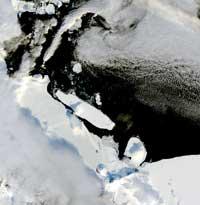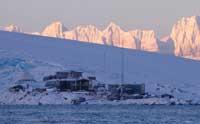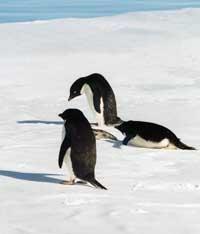The Adventures of an Iceberg
2006/11/19 Rementeria Argote, Nagore - Elhuyar Zientziaren Komunikazioa
Like the heroes of the movies, he had a short life: Born in April 2005 and died in October 2005. But let us not clarify before the end of the film.

The iceberg B-15A was born in April 2005. His mother, B-15 (now it's clear who the name comes from), was a big piece of ice, even the biggest iceberg in the world. It belonged to the Antarctic territory of Ross, separated from its ice sheet, until Ross lived in the sea. The B-15 gave birth in small ice cubes and was then born the B-15A, heir to his mother.
The B-15A was a hundred kilometers long and thirty kilometers wide. It was, of course, a smaller part than his mother, but yet it was the biggest iceberg in the world while he lived.
Naughty iceberg
Our iceberg was famous in April 2005. Researchers from NASA and ESA space agencies followed him via satellite. Driven by the currents, they saw Drigalski heading to the end of the ice and waited eagerly for the moment when the big iceberg would hit the end of the ice. What would happen to you? And the iceberg B-15A? Did it break and stop being the biggest iceberg in the world?

The B-15A iceberg was in a complicated situation on the coast, as many of the Antarctic research centers are located on the coast and are supplied by boats. (Photo: Glenn E. Grant, NSF)
Because in the end it was not as big as they expected. The B-15A did not decrease much and remained the largest iceberg.
But the worst was yet to come. After hitting the ice end, the iceberg fell against the coast. Researchers were concerned about the media: Adelie lived a colony of penguins in the area and to feed themselves they had to reach the sea. But that great iceberg was a great obstacle to reaching the sea. So on the way to the sea the penguins could die the hunger.
But Antarctic researchers were more concerned. Apparently, in addition to penguin colonies, there are three research stations in the area. And those too could hardly be maintained without the supply that came to them by sea.
Fortunately, the B-15 was not very long attached to the coast. Sea currents led to the open sea. And there he died.
Illuminated death
We recently discovered how the B-15A died. Researchers at the University of Chicago discover how the iceberg died.

These researchers analyze the music of the iceberg. It seems that icebergs produce special sounds, like rumors, which are measured by seismic sensors. Well, these sensors saw that, in addition to the music of the iceberg, they received other vibrations: that of a great storm, which sank the B-15A.
These data were contrasted with those recorded by buoys placed in the sea. And they found that a terrible storm, located about three thousand kilometers from the place where the iceberg was, caused a lot of seafood and that the waves swallowed the iceberg B-15A.
It seems that the giant iceberg B-15A had a short and random life. It will not become as well known as the one who sank the Titanic, but there is no lack of merit.
Published in 7K.




